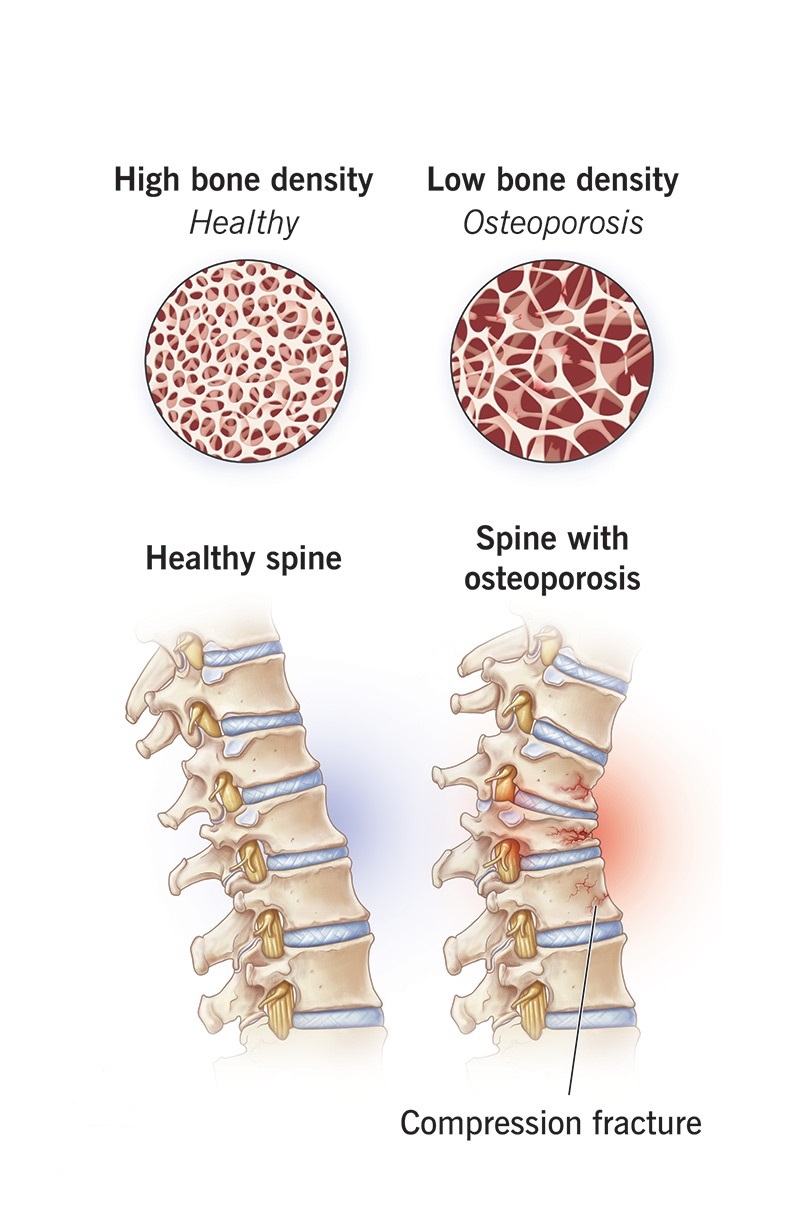This health condition weakens your bones, which makes you more susceptible to bone fracture (broken bone). Several treatments and exercises may help to prevent bone density loss. In case you have a family history of osteoporosis and you are over 65 years old, it is advised to see a doctor.
What is Osteoporosis?

Osteoporosis makes your bones thinner and less dense than usual. In normal circumstances, your bones are strong and dense, which supports your weight and absorbs most impacts. However, as you become older, the density of the bones naturally decreases and they are more fragile. Furthermore, most people do not know they have osteoporosis until they experience a bone fracture. Check below the most commonly affected areas:
- Hips
- Wrists
- Spine
In case you suspect you have osteoporosis, immediately contact a healthcare provider. Early diagnosis of this health condition can help to prevent bone fractures, especially if you are older than 65 years old.
Is osteoporosis a common health condition?
About 50 million people suffer from osteoporosis in the U.S. Moreover, this health condition is common in people over 50 years old. As per studies, 1 in 3 adults over 50 years old do not have osteoporosis yet but have a degree of decreased bone density (osteopenia). In case osteopenia is left untreated, it can become osteoporosis.
Symptoms
Healthcare providers sometimes call this health condition a silent disease because in many cases it is asymptomatic. It means that you do not notice anything until you suddenly break a bone. However, you may notice a few changes in your body, which means that you may have decreased bone density. Check some examples below:
- Changes in your natural posture
- Losing your height by an inch or more
- Shortness of breath (it occurs due to decreasing lung capacity because disks in your spine are compressed)
- Pain in your lumbar spine (lower back pain)
Causes
This disease usually occurs when you get older and bones lose the ability to reform and regrowth themselves. Bones are living tissues and they are replacing their cells throughout your life. However, after 35 years old breakdown occurs faster than your body can replace it. This factor provokes gradual loss of bone mass.
Osteoporosis Risk Factors
While anyone can develop this health condition, some people are at higher risk of experiencing it. Examples include:
- People over 50 years old
- Those who are assigned to females at birth, especially in post menopause
- Someone with a family history of osteoporosis
- People who are using tobacco products or smoke
Additionally, certain health conditions may also increase your risk of developing osteoporosis. For example:
- Blood disorders (such as multiple myeloma)
- Autoimmune disorders that affect your bones (such as rheumatoid arthritis or ankylosing spondylitis).
- Gastrointestinal diseases (such as celiac disease and inflammatory bowel disease)
- Endocrine disorders (including diseases that affect parathyroid and thyroid glands and hormones. For example diabetes and thyroid disease.
There are some drugs and surgeries that may also elevate your risk of osteoporosis. Check below some examples:
- Proton pump inhibitors (such as those used in the treatment of acid reflux)
- Anticoagulants
- Hormone therapy for cancer (such as breast or prostate cancer treatment)
- Bariatric surgery (used for weight loss)
- Medicines used in the treatment of seizures
- Corticosteroids (used to treat inflammation)
- Diuretics (these medicines help to decrease blood pressure and clear extra fluid from your body)
Furthermore, some aspects of your diet and exercise may make you more susceptible to experiencing osteoporosis. For example:
- Misuse of alcoholic beverages
- Do not get enough physical activity
- Not adding enough calcium and vitamin D to your diet
Diagnosis
A physician can diagnose this health condition with a bone density test. It is an imaging test that helps to measure the strength of your bones and it also uses X-rays to measure calcium and other mineral levels in your bones. In some cases, doctors may refer to DEXA or DXA scans. There are different names but they refer to the same test.
Verifying your bone density is the best way to diagnose osteoporosis and prevent bone fractures.
Treatment
Commonly, doctors will prescribe a combination of treatments to reduce bone loss and strengthen the existing bone tissues. However, in this treatment, it is important to prevent bone fractures. Check below the most common treatments for osteoporosis:
- Medicines – Usually, drugs prescribed by your doctor are given as injections. Some of the most common medications are hormone therapies including estrogen or testosterone and bisphosphonates. In severe cases of osteoporosis, physicians will prescribe parathyroid hormone (PTH) analogs, denosumab, and romosozumab.
- Vitamin and Mineral Supplements – Over-the-counter medicines are used as calcium and vitamin D supplements. Your healthcare provider will prescribe the dosage and duration of the treatment of these supplements.
- Exercise – Your doctor may suggest regular exercises that will help to strengthen your bones and all tissues connected to them including tendons, ligaments, and muscles. Some of the exercises that your physician may prescribe are weight-bearing exercise, walking, yoga, tai chi, Pilates, and others. Talk with your healthcare professional for more details.
How Can I Prevent Osteoporosis?
There are some tips that may help to reduce the risk of osteoporosis such as getting enough calcium and vitamin D. Check some tips below:
- Always wear your seatbelt.
- During all activities and sports, wear the right protective equipment.
- Make sure that at home and workspace are free from clutter.
- Use proper tools or equipment at home to reach things. Do not stand on tables, chairs, or countertops.
- Adopt an exercise and diet plan that’s right for you.
- It is advised to use a walker or cane if you have walking problems or an elevated risk of falls.
Frequently Asked Questions
When should I see my healthcare professional?
In case you think you have osteoporosis symptoms, it is time to see a doctor. Additionally, inform your physician about symptoms you notice such as trouble moving, bone pain, or others.
What questions should I ask my doctor?
- Will I need physical therapy for my health condition?
- What exercises can I do to improve bone tissues?
- What treatments are available for this disease?
- How often should I do a bone density test?
- What are the main risks associated with osteoporosis?
Is osteoporosis a curable condition?
Unfortunately, not complete, once it starts, it may be not possible to recover bone tissue. Anyway, different treatment options are available to treat this condition. Discuss with your healthcare professional to get the treatment right for you.




